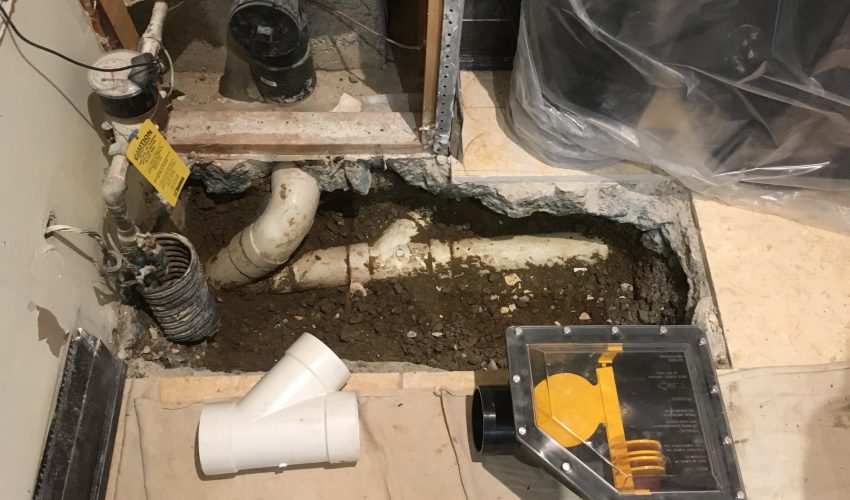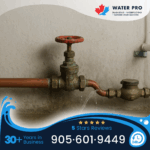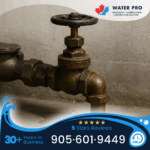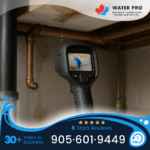Protecting your property from flooding and sewer backup is crucial, especially in the Greater Toronto Area, where basement flooding is common. Installing a backwater valve can prevent wastewater from entering your property through the sewer system during floods or heavy rains.
In Toronto, the cost to install a backwater valve depends on the complexity of your project, the type of installation, and additional fees such as permits. You can expect to pay $1,600 to $2,600 for interior backwater valve installation or $2,400 to $4,200 for exterior backwater valve installation.
What’s a Backwater Valve?
Also known as a sewer backup valve or a backflow valve, a backwater valve is a special device installed on the primary wastewater line that connects your property to the main (public) sewer system. It prevents wastewater or sewage from flowing back into your home.
Sometimes, heavy rainfall and floods can overwhelm public sewer lines. This can cause potential backflows into commercial and residential properties. A backwater valve keeps the water flowing in one direction – away from your home.
How Does a Backwater Valve Work?
Backwater valves work using a simple but efficient principle. They have a flap inside. The flap allows drain pipes to direct wastewater from your property to the public or main sewer line. This flap stays open always, allowing wastewater to flow smoothly.
Suppose the public sewer line is overwhelmed during heavy rains. In that case, sewer water may flow backward towards your property. This will push the flap (valve) to close automatically and stop dirty water from flowing back into your home. Once the sewer water pressure drops (sewage backup stops), the flap will open automatically, allowing waster water to continue flowing away from your home.
Backwater Valves Vs. Backflow Preventers
Sewer backup valves should not be confused with backflow preventers. First, these valves are installed on the main wastewater line, while backflow preventers are installed on freshwater lines. Secondly, backwater valves prevent sewage from flowing back to your home, while backflow preventers prevent contaminated water from reversing into a clean water supply.
There are also backflow preventers designed for electrical appliances and garden hoses. These appliance backflow preventers keep the water from flowing back and contaminating your water supply. Note that backflow preventers for sprinkler or sewer systems are larger and more complex than appliance and hose backflow preventers.
Benefits of Installing a Backwater Valve
Here’s why you should have a backwater valve installed on your property.
Prevent Basement Flooding
Nearly every home with a basement faces the risk of water seeping into the basement during heavy rains. If the main sewer line becomes overwhelmed, the sewage will likely flow out at the lowest possible point. That’s why basements are at a higher risk of flooding with wastewater.
An efficient backwater valve installed at the right point of your property’s plumbing system can stop the contents of the local sewer line from flowing back into your basement drains. Thus, the valve can help keep your basement floor dry.
Prevent Sewage Backflow
In addition to the damage associated with sewage flowing back into your property, the contaminated contents of sewers pose a health hazard. This liquid contains countless contaminants that pose a significant health threat to everyone in your home. A backwater valve can ensure raw sewage does not flow backward into your home.
Save Thousands of Dollars in Flood Repairs
Sewage backup can flood your basement and, in the worst-case scenario, your entire home. This can lead to loss of personal belongings and different forms of water damage to your home. Luckily, installing the right valve in your property’s main wastewater line can prevent the costly repairs associated with flooding. So, consult a licensed master plumber who can inspect your sewer line and install a backwater valve appropriately.
Types of Backwater Valves
Different types of backwater valves are suited for different needs. Here are the common types of these valves.
| Type of Backwater Valve | Description |
| Flap-style valves | These valves are very common in Toronto properties and use a hinged flap that automatically opens to let wastewater flow away from your property. If there’s a sewage backflow, the valve closes automatically to prevent the contents of the city sewer pipe from flowing into your home’s plumbing. |
| Gate-style valves | The valves utilize a sliding gate mechanism to ensure your home’s main sewage pipe carries wastewater in one direction only (towards the public sewage system). |
| Combination Valve | This is a special valve designed for basements. It consists of a chamber and gate that senses flood water and stops backwater flow. The valve also closes the basement floor drain to ensure wastewater never flows back to your property. This combination valve is the most expensive, as it rarely fails. |
| Swing-check valve | This is a self-cleaning disc that rotates to stop sewer gas from circulating. It also closes automatically to prevent sewage from flowing back into your home. |
Each of these valve types has unique benefits and limitations. Consult a licensed plumber to determine the right valve type and valve diameter for your main sewer pipe.
Installation Process
The process of installing a backwater valve involves several steps to ensure effective function. These include:
Step 1: Assessment
A professional plumber should assess your home to determine the optimal location for the valve installation. The professional will consider the plumbing layout, access points, and construction codes or regulations.
Step 2: Preparation and Excavation
Once the optimal location for the valve installation has been identified, the plumber will prepare the site by clearing any obstruction. If the valve is supposed to be installed on buried pipes, excavation may be necessary. Also, excavation may be needed to access your home’s sewer line.
Step 3: Valve Installation
In most cases, plumbers recommend flap-style backwater valves. The valve should be secured inside your home’s main sewer line. After installation, your plumber will then connect the valve to your home’s plumbing network while ensuring a water-tight seal. This will ensure wastewater cannot flow back into your drain pipes.
Installation Cost
The cost of installing a backwater valve in Toronto homes ranges from $2,000 to $5,000 if you’re retrofitting into an existing property. The cost is high because the entire process of installing the valve into an already existing piping system is labour-intensive. Just think about it: you need to break through your property’s foundation to access the sewer line.
However, if you’re installing a backwater valve during the construction of a new property, the cost could be as low as $500. The valve can be easily integrated into the plumbing plan without having to excavate or tamper with old pipes.
Maintenance and Repair Cost
Backwater valve maintenance is crucial to ensure it stays efficient and prevents home flooding, mainly through sewage backup. Here are the costs associated with regular maintenance of backwater valves.
Regular inspection and cleaning: A skilled plumber should inspect and clean the valve thoroughly annually. During these annual inspections, your plumber can easily identify any obstructions and signs of wear.
Annual testing: A plumbing professional can help check whether the flap moves freely and the seal is intact. They can also test whether the valve is working efficiently. This is also a good time to replace any damaged or worn-out parts.
It’s recommended to avoid using harsh chemicals on your backwater valve as they can corrode or damage the valve. Be sure to keep a detailed record of all inspections, valve cleanings, and repairs. Such information can help troubleshoot future plumbing issues.
Municipal and Provincial Subsidies
Toronto City offers up to 80% subsidy of the invoiced cost (up to $1,250) of installing flood protection devices. The local municipality recognizes the installation or replacement of a backwater valve as a flood protection device. This subsidy is intended to offset the cost of installing the valve and applies regardless of the number of devices you have installed on your property. It covers eligible materials, labour, and taxes.
Note that you need a building permit to install the valve on your property. Before the installation process begins, it’s best to verify whether your plumber has a valid license to operate in Toronto City. In addition, the valve being installed must undergo a special inspection by the city’s building inspector. You must ensure proper valve maintenance – regular inspection and cleaning – according to the product specifications.
If you violate any of these conditions, your backwater valve won’t be eligible for the city subsidy.
Home Insurance and Sewer Backup Prevention
Notify your home insurance provider of any installation of a backwater valve in your home, especially if you live in an area prone to heavy rainfall and floods. The presence of the valve could affect the rate you’re charged in your home insurance.
Some insurance providers even recommend or require you to have a backwater valve installed in your home. This may be a mandatory requirement for your home insurance policy to cover damage associated with sewage backflow.
Importance of Professional Installation
Sure, you can watch a few YouTube guides and learn how to install a backwater valve. This won’t make you a licensed plumbing professional. Keep in mind that a professional plumbing contractor should handle the entire backwater valve installation process. Otherwise, your property won’t be eligible for the Toronto City subsidy program.
In addition, your home insurance provider may not accept DIY backwater valve installation and maintenance. Therefore, you should work with a professional who can guarantee proper valve installation and maintenance. Besides, proper installation will ensure your valve functions optimally.
Conclusion
Unless you have installed a backwater valve, there’s a risk that your home could experience wastewater backup every time there’s a sudden downpour. Well, it’s terrible when rainwater floods your basement; try to imagine filthy sewage flowing back into any part of your home. Talk to a licensed plumbing contractor and install a backwater valve.
FAQs
Can you install a backwater valve yourself?
The valve installation process requires technical skills and knowledge of the local building codes. Therefore, it’s recommended to have a plumbing professional handle the installation process.
What’s the life expectancy of a backwater valve?
With proper installation and maintenance, your valve should last 5 to 10 years. Follow the manufacturer’s instructions regarding installation and maintenance.






